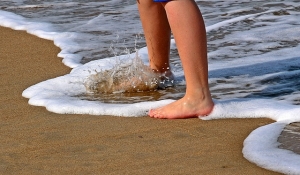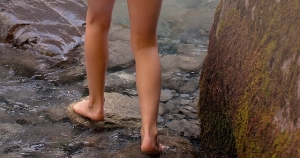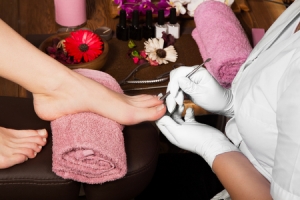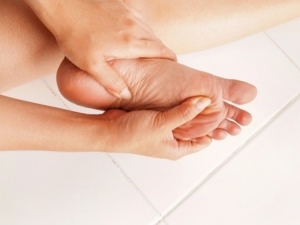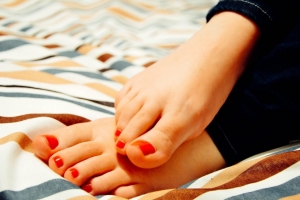Connect With Us
Blogs
Displaying items by tag: Warts
8 Ways to Protect Your Feet if You Have Diabetes
November is American Diabetes Month and at Superior Foot & Ankle Care Center this is a topic of high importance. Diabetes has the potential to seriously impact the health of your feet. When blood sugar levels are high, your immune system can be compromised, and your body may have difficulty fighting infections. Two other conditions associated with diabetes—poor circulation and peripheral neuropathy (loss of feeling) — can conspire to put your feet at risk for dangerous wounds and infections. Diabetes can also affect your bones, joints, and skin. This year’s message from the American Diabetes Association, however, is one of hope: “We Stand Greater Than Diabetes.” The good news is that there are many ways to prevent podiatric problems if you have diabetes. Below are eight to consider:
- Schedule regular podiatric exams. Our podiatrists, Victoria M. Foley and Dr. Constance Ornelas, are an important part of your health care team if you have diabetes. Seeking care regularly will help the foot doctor spot problems before they get out of control and help you be proactive in protecting your feet.
- Check your feet daily. Getting in the habit of examining your feet—top, bottom, between the toes and toenails—will enable you to spot any changes promptly. Cuts that aren’t healing, redness, swelling, bruising, growths, or changes in skin color or nails may all be signs that something potentially harmful is developing. Any changes should be reported promptly to our Long Beach office by calling: (562) 420-9800.
- Choose your shoes carefully. Avoid stiff shoes and look for styles that have roomy toe boxes. Get your feet measured and fitted professionally and periodically run your hand around the inside of the shoes to make sure there are no rough seams or material that could cause friction and blisters.
- Don’t smoke. It impedes circulation.
- Keep feet dry. Sitting in damp footwear can increase your risk of athlete’s foot and fungal toenails.
- Don’t go barefoot. Even at home, wear slippers or shoes to prevent cuts and puncture wounds.
- Do not use medicated pads, acid solutions, or sticky pads. For warts, corns, and calluses consult your podiatrist for treatment and don’t attempt any “bathroom surgeries.”
- Follow your doctor’s instructions for managing your diabetes. Take your medications as directed, eat a nutritious diet, maintain a healthy weight, and exercise regularly.
Beach Day or Bust?
At Superior Foot & Ankle Care Center, we know that many of our patients like to relax by spending a day at the beach. However, besides rain, nothing ruins a beach day faster than a foot or ankle injury. Below are some easy ways to avoid foot trouble and enjoy some fun in the surf and sand.
Watch out for Jellyfish—a dead jellyfish that has washed up on the shore through its tentacles can still sting you. If this happens, use gloves to protect your hands and gently remove the tentacles. Apply vinegar or baking soda to help the pain and swelling decrease.
Wear Flip Flops—this is one of the few times that you will hear us recommend flip-flops, but for a beach day, they can help your feet in several ways:
- Getting from the car to your beach blanket, they will prevent the soles of your feet from being burned by the hot asphalt or the sand that’s been baking in the sun.
- For walks on the beach, flip-flops can protect your feet from cuts from sharp shells and puncture wounds from debris hidden in the sand.
- When using the changing area or restroom, flip-flops will keep you from coming in contact with bacteria, viruses, and fungus that cause athlete’s foot, warts, and other
Re-Apply Sunscreen—a water-resistant sunscreen that has an SPF of 15 or higher should be used on the tops and bottoms of your feet if you are laying out on the beach. To be effective in preventing sunburn, it needs to be reapplied every two hours, and after each time you take a dip in the ocean.
Bring Sneakers—if beach volleyball, Frisbee or other active games are part of your idea of fun at the shore pack sneakers in your beach bag. Wearing flip-flops or playing barefoot can increase your risk for an ankle sprain in the shifting sands.
Remember Your Water Bottle—drinking lots of water is not only essential for staying hydrated, it helps you avoid swelling of the ankles and feet which can be painful and make it difficult to fit into your shoes for the ride home.
If your beach day results in an injury, rash or other foot or ankle symptoms, make an appointment at our Long Beach office (562-420-9800) promptly so that our podiatrists, Dr. Victoria M. Foley or Dr. Constance Ornelas can examine your feet and treat any podiatric problems.
Avoid Summer Foot Hazards
During the summer months your feet experience some particular challenges. At Superior Foot & Ankle Care Center we want to alert our patients to some potential foot and ankle problems and ways to prevent them.
Puncture Wounds and Cuts—going bare foot increases your risk of stepping on a sharp object. If this does happen and you sustain a puncture wound or cut be sure to clean it out completely and apply an antibiotic ointment and a bandage. Avoid swimming in lakes or the ocean while the wound remains open to prevent an infection from developing. If the area around the wound starts to feel warm or you notice redness or any pus or discharge, contact our Long Beach office immediately by calling: (562) 420-9800. Our podiatrists, Dr. Victoria M. Foley or Dr. Constance Ornelas will examine your foot and determine if you need treatment.
Fungal Infections—athlete’s foot, fungal toenails and warts are among the bacterial and fungal infections that are spread by direct contact. For this reason, we recommend keeping your feet covered in public places like community pools, gym locker rooms and showers and the nail salon.
Heel Pain—if flip-flops are your summer go-to shoes, you may notice an increase in heel pain. The average pair of flip-flops provides no arch support. Flattening of the arch exerts more pressure on your heel. If this is your footwear of choice, invest in a pair designed with sturdy soles and built in arch support.
Ankle Sprains—unfortunately many other summer shoe styles are also lacking in side, ankle and arch support. While these may be fine for dinner out or a special occasion, be sure not to wear them for extended periods of walking or sports activities as this likely to result in an ankle twisting injury.
Fortunately, a little common sense and smart choices can go a long way toward protecting your feet this summer. If you have foot pain or discomfort, don’t hesitate to contact us for an appointment.
Show Some Gratitude for Your Feet
It’s the season of Thanksgiving and here at Superior Foot & Ankle Care Center we think your feet deserve to be on the list of things that you’re thankful for! The 26 bones, 33 joints, 107 ligaments and 19 muscles in each of your feet work together in complex and amazing ways to enable you to do all the activities you enjoy. Why not show your feet some gratitude with one or more of these proactive podiatric health ideas:
Pay attention: Many times your feet are the starting place of diseases that affect your entire body such as diabetes, arthritis, circulatory and nerve problems. Get in the habit of inspecting your feet regularly and report any unusual changes to the foot doctor. Even more minor problems—ingrown toenails, warts, athlete’s foot—are more easily treated when caught in their earliest stages.
Do a shoe review: Are your shoes hurting your feet? Check to see that the shoes you wear have adequate arch and ankle support as well as cushioning for the sole. This will go a long way to preventing foot injuries and chronic conditions. Look for signs of wear and don’t continue to use shoes that are stretched out or have tears or loose stitching.
Have a spa day: pamper your feet with a relaxing foot soak. Then carefully trim toenails (straight across and not too short to avoid ingrown nails). Finish with a rich moisturizer massaged into your feet. If you prefer a salon pedicure just be sure to choose a place that follows proper sanitizing procedures for foot baths and tools to prevent fungal infections.
Watch your weight: being overweight puts excess strain and pressure on your feet and is a contributing factor in many foot problems. Maintaining a healthy weight will help reduce foot pain.
Get a checkup: When’s the last time you were in to our Long Beach office? Make an appointment by calling 562-420-9800 and let our podiatrists, Dr. Victoria Foley and Dr. Constance Omelas examine your feet. The foot doctor can alert you to any potential problems and make recommendations for ways that you can help keep your feet healthy.
Summer Checklist for Preventing Children’s Foot Problems
Chances are with the end of the school year your child came home with readings lists and other summer work. At Superior Foot & Ankle Care Center we’d like to add one more list: a checklist for taking care of your child’s feet over the summer months. Summer brings a whole new set of activities and options for children, many of which can lead to foot trouble if the proper precautions are not taken. Here are our top tips for keeping children’s feet healthy this season:
Slather on the Sunscreen—many people forget to apply sunscreen to their feet. The skin on your feet is just as susceptible to the harmful effects of UVB and UVA rays as that on the rest of your body. On beach and pool days you should put sunscreen on the tops and bottoms of your children’s feet and reapply after swimming. If your children are wearing sandals or other open shoes and will be out in the sun shopping or sightseeing you should also put sunscreen on their feet then.
Pack the Flip Flops—summertime is high season for athlete’s foot, fungal toenails and warts, all of which are spread by direct contact with the virus, fungi or bacteria that cause them. If you are spending time at a community pool or local beach make sure your child keeps their feet covered around the pool and in changing areas and bathrooms—these are prime hangouts for fungal infections. Encourage your children not to share shoes, socks, towels or any items that touch someone else’s feet.
Inspect Shoes—be sure that your child is wearing shoes that match the activity they are participating in. While flip flops are good for the pool, they can lead to injury if used for playing whiffle ball or other casual summer sports. Also keep an eye on fit—children’s feet grow fast and time spent squeezed into shoes that are too tight can increase the risk of ingrown toenails and fungal infections.
Keep it Clean—wash your children’s feet at the end of every day with a mild soap and warm water. Be sure to dry completely as well, especially between the toes. Trim toenails straight across with no curved edges. If your child’s feet sweat excessively, consider a foot powder to help keep them dry.
If when caring for your child’s feet you notice anything unusual or concerning, or if your child complains of foot pain, don’t hesitate to contact our podiatrists, Dr. Victoria Foley and Dr. Constance Omelas at our Long Beach office by calling 562-420-9800. It’s always better to get a foot concern checked than to wait and have it develop into a serious issue. Enjoy the summer and keep your children’s feet safe!
Take a Good Look at Your Feet
When’s the last time that you took a good look at your feet? At Superior Foot & Ankle Care Center, we believe regularly examining your feet is a key component of good foot health. In addition, your feet are the part of your body where several systemic conditions such as diabetes, arthritis and peripheral neuropathy may first exhibit symptoms. You can examine your feet in as little as 10 minutes. Ready, set, go:
- Start by standing with your feet together and look down at them. Do you notice any difference between your two feet in size or shape? Is there any swelling in your ankles or feet?
- Now sit down so you can get a closer look at each foot. Examine the top, bottom and sides of your feet as well as between your toes. If you see any cuts or wounds make sure they are clean and appear to be healing. Check your skin. Do you notice any redness, dry flaky skin, rashes or bruises? Do you have any unusual freckles or moles that appear to have changed since the last time you looked at them? Do you see any lumps, growths, warts or new calluses?
- Examine your toenails. Nails that are discolored, thick or crumbling at the edge may indicate a fungal condition. A bluish or purplish tinge to the skin under your nails is a possible sign of a circulation issue.
- While you’re seated, take a pencil and run the erased end over the top, bottom and sides of your foot. The sensation should be equal in all parts of your foot.
- Lastly, flex your toes and feet. Do you notice any pain or stiffness in your joints?
If you spot anything that doesn’t seem quite right, contact our Long Beach office for an appointment by calling: (562-420-9800). Our podiatrists, Dr. Victoria Foley and Dr. Constance Omelas, will give your feet a complete examination and assess whether you have a foot health issue.
Making this quick foot self-check a part of your monthly health routine will go a long way to preventing foot problems as well as detecting any conditions that do develop in their very earliest stages when treatment is usually less invasive and more effective.
Home Plantar Wart Treatment
How To Treat Plantar Warts At Home
A plantar wart is one of just a few soft tissue conditions, which can be very painful. It is also very common, and can be treated at home with common household items or over-the-counter products.
Treating Plantar Warts: Causes and Symptoms
Plantar warts are caused by a virus which invades the skin through small or even invisible cuts and abrasions. It is most often contracted while walking barefoot on dirty surfaces or littered areas.
Communal bathing facilities and other warm, moist environments are also breeding grounds for the virus.
Plantar warts are found on the bottom of the feet. They tend to be hard and flat, with a rough surface and defined boundaries. They are often gray or brown (colors may vary) with one or more pinpoints of black. Left untreated, the warts may grow to an inch or more and may even spread into clusters (often called mosaic warts).
These warts are very resistant to treatment, and may even return after healing; but some have been known to disappear on their own. Though warts may be painful on weight-bearing areas of the feet (e.g. the ball of the foot or the heel), most warts are harmless.
Read more about warts and how to identify them here.
Plantar Wart Treatments: Home remedies
Peeling Medicine
Nonprescription wart removal methods typically come as a patch or liquid. The directions usually tell patients to wash the affected area and soak it for 20 minutes. Gently remove the dead tissue with a pumice stone or emery board, then apply the solution or patch. Patches are typically changed every 48 hours, while liquid applications are applied twice a day. Results may not appear for several weeks.
Cryotherapy
You may be able to get this kind of treatment from the doctor . The doctor will trim the wart with a small knife. In rare cases, local anesthetic may be administered. Then, the doctor applies liquid nitrogen with a probe or cotton swab.
Duct Tape
For this method, cover the wart with silver duct tape for six days, then soak the wart in water. Remove the dead tissue with a pumice stone or emery board, and leave the wart exposed for 12 hours. Repeat this process until the wart is gone. Keep in mind that this method has seen mixed results at best.
You may want to discuss these methods with your doctor first. Most over-the-counter wart treatments will contain acids or chemicals which destroy skin cells. An expert hand will be able to destroy the abnormal skin cells without harming the surrounding healthy tissues. Patients with diabetes, cardiovascular diseases, or circulatory disorders should avoid self-treatment entirely.
Prevention
There are a few steps to take in order to prevent plantar warts from forming:
- Avoid direct contact with warts, including your own.
- Keep feet clean and dry, and change shoes and socks daily. This basic step is essential for preventing blisters and fungal infection as well.
- Wear shoes or sandals in areas where the wart virus thrives, such as communal showers, dirty areas, and swimming and pools.
- Don’t pick at the warts, as this may cause the virus to spread.
Reserve a different pumice stone or emery board for the warts, and another for healthy skin and nails. - Use a disposable emery board to avoid spreading the virus
Wash hands thoroughly after touching a wart. - Check children’s feet regularly.
When To See a Doctor
If you have a plantar wart and the treatments listed above haven’t been effective, you should see a doctor about other treatment options. Generally, it is always a good idea to see a doctor whenever there is a growth or eruption on the feet to ensure the correct diagnosis. Sometimes, what appears to be a wart may actually be a sign of cancer – for example, carcinoma or melanoma.
Ask the Experts
If you are concerned about a wart that won’t go away, schedule an appointment with Dr. Vikki or Dr. Connie today. For more foot care advice, contact the specialists at Superior Foot & Ankle Care Center.

